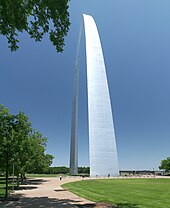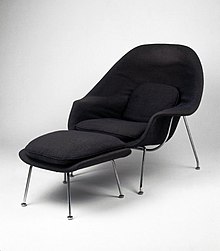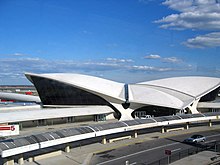Eero Saarinen
Eero Saarinen (Kirkkonummi, Finland, August 20, 1910 - Ann Arbor, Michigan, September 1, 1961) was a Finnish architect and industrial designer who also had American nationality.
Biography
He was born in Kirkkonummi. Her mother was the sculptor Louise (Loja) Gesellius, later Saarinen, and her father was the well-known architect Eliel Saarinen. When she was 13 years old, her parents immigrated to the United States.
Eero Saarinen initially studied sculpture at the Académie de la Grand Chaumiére in Paris and later architecture at Yale University. He received a scholarship to travel to Europe again, where he stayed for two years. On his return he was Professor of Architecture at the Cranbrook Academy of Art. He also began working at the firm 'Saarinen, Swansen and Associates', headed by Eliel Saarinen and Robert Swansen from the late 1930's until Eliel's death in 1950. The firm was located in Bloomfield Hills, Michigan, until 1961, when the studio was moved to Hamden, Connecticut.
Saarinen first received critical recognition, while still working for his father, for a chair co-designed with Charles Eames for the "Organic Design in Home Furnishings" in 1940, for which they received first prize. The 'Tulip chair', like all other Saarinen chairs, was put into production by the Knoll furniture company, founded by Hans Knoll, who married Saarinen family friend Florence (Schust) Knoll.. When Saarinen was still working for his father, he also received first prize in the competition for the design of the Jefferson National Expansion Memorial in St. Louis, which was not completed until the 1960s. The prize was mistakenly sent to his father. father.
During his long association with Knoll he designed many important pieces of furniture including the "Grasshopper" and Ottoman (1946), the "Womb" (1948), the "Womb" (1950), and the most famous group of his & # 34;Tulip & # 34; or "Pedestal" (1956), which featured side and arm chairs, dining, coffee, and side tables as well as a stool. All of these designs were highly successful, except for the "Grasshopper" lounge chair, which, although in production until 1965, was not a great success.
One of Saarinen's earliest works to receive international acclaim is The Crow Island School in Winnetka, Illinois (1940). Saarinen's first major work, in collaboration with his father, was the General Motors Technical Center in Warren, Michigan, which follows the rationalist style of the Miesian style, incorporating steel and glass, but with the added accent of paneling in two shades of blue. GM's technical center was built in 1956, with Saarinen using models, which allowed him to share his ideas with others, and collect input from other professionals.
With the success of the center, Saarinen was invited by other major US corporations such as John Deere, IBM and CBS to design their new headquarters or other major corporate buildings. Despite their rationality, however, the interiors often contained dramatic escalators, as well as Saarinen-designed furniture such as the Pedestal Series. In the 1950s he began to receive more commissions from American universities for campus designs and individual buildings. These included Noyes' Vassar dormitory, Hill College House at the University of Pennsylvania, as well as an ice rink, Ingalls Rink, Ezra Stiles & Morse Colleges at Yale University, the MIT Chapel and the neighboring Kresge Auditorium at MIT and the University of Chicago, the law school building.
Saarinen served on the jury for the construction of the Sydney Opera House in 1957 and was instrumental in the selection of Jørn Utzon's now internationally renowned design. A jury not including Saarinen had ruled out Utzon's design in the first round, Saarinen reviewed the discarded designs, recognized a quality in Utzon's design, and ultimately secured Utzon's award.
After his father's death in July 1950, Saarinen founded his own architectural firm, "Eero Saarinen and Associates". He was senior partner from 1950 until his death in 1961. Under Eero Saarinen, the firm completed many of his projects, including Bell Labs' Holmdel Complex in Holmdel Township, New Jersey, the Jefferson National Expansion Memorial (including the Gateway Arch) in Saint Louis, Missouri, the Miller House in Columbus, Indiana, the TWA Flight Center at New York's Kennedy International Airport which he designed with Charles J. Parise, the main terminal at Dulles International Airport near Washington D.C., the new eastern terminal of the Athens airport that opened in 1967, and so on. Many of these projects use catenary curves in their structural designs.
One of the best-known thin-set concrete structures in America is the Kresge Auditorium (MIT), which was designed by Saarinen. Another slender roof structure he created is Yale's Ingalls Track, which has suspension cables attached to a single concrete spine and is nicknamed 'the whale'. Undoubtedly his most famous work is the TWA Flight Center, which represents the culmination of his previous designs and demonstrates his neo-futuristic expressionism and technical marvel on concrete roofs.
Eero also worked with his father, mother, and sister designing elements of the Cranbrook campus in the hills above Bloomfield, Michigan, including Cranbrook School, Kingswood School, Cranbrook Academy of Art, and Cranbrook Science Institute.
Saarinen became famous for his designs of curved lines, especially on the roofs of his buildings, with which he managed to give them great lightness. He is frequently associated with what has come to be called international architecture.
Saarinen died on September 1, 1961, at the age of 51 while undergoing an operation for a brain tumor. She was in Ann Arbor, Michigan overseeing the completion of a new music building for the University of Michigan School of Music, Theater and Dance. He is buried at White Chapel Memorial Park Cemetery, in Troy, Michigan.
Representative works
- Arco Gateway (San Luis, Missouri)
- Hellinikon International Airport
- Kresge Auditorium, Massachusetts Institute of Technology (Boston)
- Bell Laboratories Building (Holmdel, New Jersey)
- CBS Building (Black Rock, New York)
- Teatro Vivían Beaumont, Lincoln Center (New York)
- Dulles International Airport (Washington)
- TWA Terminal, Kennedy Airport (New York)
- General Motors Technical Centre (Warren, Michigan)
- U.S. Embassy. in Oslo
- U.S. Embassy. United States in London
- North Christian Church (Columbus, Indiana)
- Hokey David S.Ingalls Stadium at Yale University (New Haven, Connecticut)
- Miller House (Columbus, Indiana)
Contenido relacionado
The Rolling Stones
The Prisoner of Zenda (1952 film)
Tambo (architecture)


